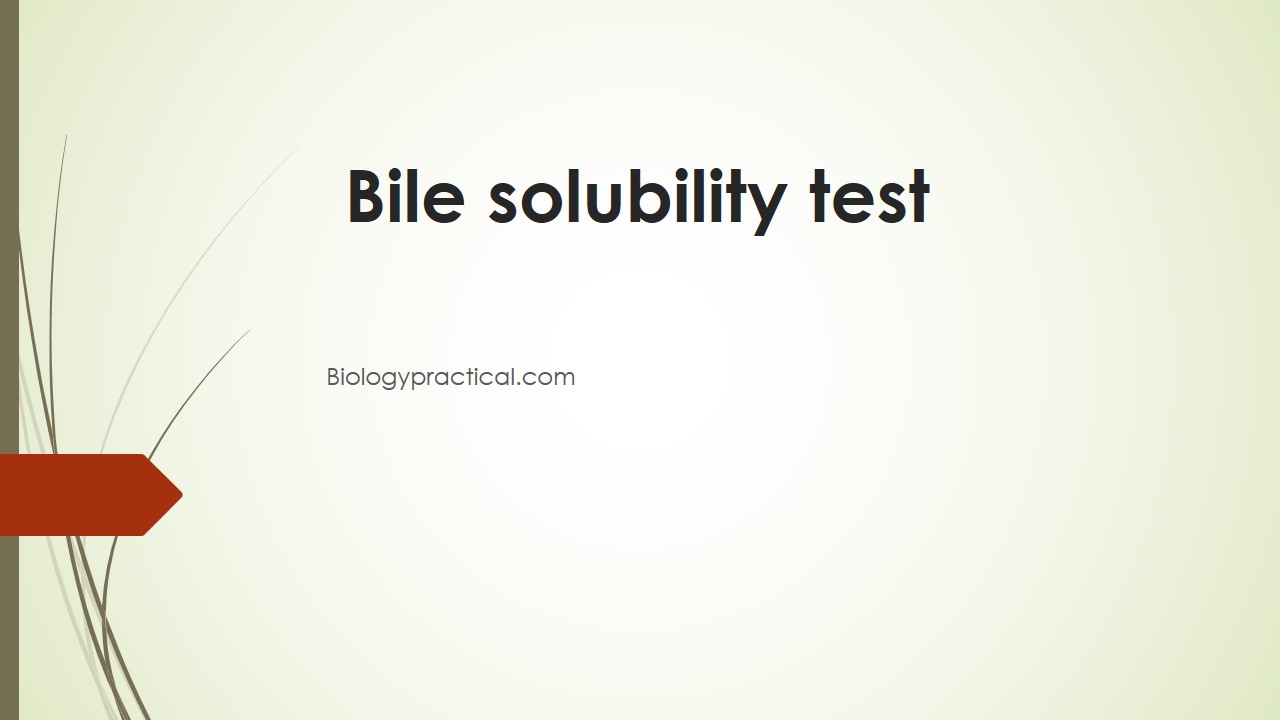
Principle of Bile solubility test :
The bile solubility test is employed to distinguish Streptococcus pneumoniae from alpha-haemolytic Streptococcus spp. The basis of bile solubility test is the lysis of pneumococcal cells when bile salts especially sodium desoxycholate and sodium taurocholate is applied to the colony under particular conditions of time and temperature, whereas other streptococci do not. An amidase is an intracellular autolytic enzyme possessed by pneumococcus that is responsible for the rapid autolysis of the organism, when cultivated on artificial medium. The bile salts lowers the surface tension of the medium and cause cell membrane disruption. The working mechanism of the test is not clearly known; however, one theory states the bile salts accelerates lysis of pneumococcal cells by activating the autolytic enzyme.
Requirements:
- Inoculating Loops
- Test tubes or slide
- Pipettes
- Sodium desoxycholate
- 0.85% NaCl
- Broth culture medium
Procedure of Bile solubility test:
A. Test tube method:
- Dispense 0.5 ml of sterile saline or suitable broth into a small test tube.
- Prepare a heavy suspension of the organism in normal saline.
- Shake or vortex to form a uniform suspension of the organism
- Divide the suspension into two tubes, one labelled “TEST” and the other labelled “CONTROL.”
- Dispense 5 drops of bile reagent into the tube marked “TEST.”
- Add 5 drops of saline to the tube marked “CONTROL.”
- Gently mix each tube.
- Incubate the tubes for 3 hr at 35°C, checking hourly for clearing, or examine each tube by Gram stain or methylene blue wet mount for lysis of cells at 15 min.
B. Direct plate method:
- Place a drop of bile spot reagent near a suspected 18 to 24-h colony; gently roll the drop over several representative colonies by tilting the plate. Take care not to dislodge the colonies.
NOTE: Make sure not to touch the agar surface with the tip of the dropper of bile reagent. - Keep the plate right side up and incubate at 35°C for 15 to 30 min or until the drop has evaporated.
- Placing the plate on a heat block is a substitute for use of an incubator.
- Observe for flattening of the colony.
- Make sure the colony did not simply float away.
C. Direct slide blood culture test:
- Add 1 drop of blood culture broth to 1 drop of bile reagent on a glass slide and allow to dry.
- As a control, add 1 drop of broth blood culture to 1 drop of water and allow to dry.
- Gram stain and examine for cocci.
Results interpretation:
Test tube method:
- Positive result: It is indicated by clearer or loss of turbidity in suspension in contrast to control which is turbid. Eg. Streptococcus pneumoniae
- Negative result: It is denoted by the turbidity of suspension. eg. Streptococcus mitis

Direct plate method:
- Positive result: It is demonstrated by the flattening of colony or disintegration of colony within 30 mins, leaving an area of alpha hemolysis where the colonies were located.
- Negative result: is indicated by the intact colony or no change in integrity of the colony within 30 min.
Direct slide blood culture method:
- Positive result: The complete lysis of all the cocci in smear is suggestive of positive result.
- Negative result: Intact colony of cocci in both control and test is indicator of negative test.
Limitations:
- Even if the lysis doesn’t take place, the organism can still be S. pneumoniae . Thus colonies resembling S. pneumoniae but bile insoluble should be further processed to other biochemical tests for identification.
- The bile solubility test is not valid with old cultures that have autolysed.
- While the test is performed using the plate method, proper care should be taken not to dislodge the colony being tested, thus yielding false-positive results. If the direct plate method is difficult to interpret, the test should be repeated using the tube or slide method.
